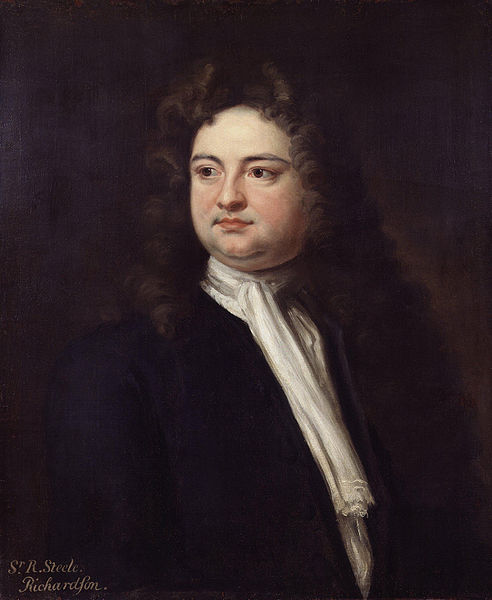<Back to Index>
- Physicist Gunnar Nordström, 1881
- Composer Thomas Augustine Arne, 1710
- Member of Parliament Richard Steele, 1672
PAGE SPONSOR

Sir Richard Steele (bap. 12 March 1672 – 1 September 1729) was an Irish writer and politician, remembered as co-founder, with his friend Joseph Addison, of the magazine The Spectator.
Steele was born in Dublin, Ireland, in March 1672 to Richard Steele, an attorney, and Elinor Symes (née Sheyles); his sister Katherine was born the previous year. Steele was largely raised by his uncle and aunt, Henry Gascoigne and Lady Katherine Mildmay. A member of the Protestant gentry, he was educated at Charterhouse School, where he first met Addison. After starting at Christ Church in Oxford, he went on to Merton College, Oxford, then joined the Life Guards of the Household Cavalry in order to support King William's wars against France. He was commissioned in 1697, and rose up in the ranks to captain of the 34th Foot in 2 years. He disliked British Army life, and left the army in 1705, perhaps due to the death of the 34th Foot’s commanding officer, and with him, his opportunities of promotion. It may then, be no coincidence that Steele's first published work, The Christian Hero (1701), attempted to point out the differences between perceived and actual masculinity.
In 1706 Steele was appointed to a position in the household of Prince George of Denmark, consort of Anne of Great Britain. He also gained the favour of Robert Harley, Earl of Oxford.
In 1705, Steele married a widow, Margaret Stretch, who died in the following year. At her funeral he met his second wife, Mary Scurlock, whom he nicknamed "Prue" and married in 1707. In the course of their courtship and marriage, he wrote over 400 letters to her. They were a devoted couple, their correspondence still being regarded as one of the best illustrations of a happy marriage, but their relationship was stormy. Mary died in 1718, at a time when she was considering separation. Their daughter, Elizabeth (Steele's only surviving legitimate child), married John Trevor, 3rd Baron Trevor.
Steele became a Member of Parliament of the United Kingdom in 1713, but was soon expelled for issuing a pamphlet in favour of the Hanoverian succession. When George I of Great Britain came to the throne in the following year, Steele was knighted and given responsibility for the Theatre Royal, Drury Lane, London. While at Drury Lane, Steele wrote and directed The Conscious Lovers, which was an immediate hit. However, he fell out with Addison and with the administration over the Peerage Bill (1719), and in 1724 he retired to his wife's homeland of Wales, where he spent the remainder of his life.
A member of the Whig Kit-Kat Club,
Steele remained in Carmarthen after Mary's death, and was buried there,
at St Peter's Church. During restoration of the church in 2000, his
skull was discovered in a lead casket, having previously been
accidentally disinterred during the 1870s. As
mentioned above, in 1701, Steele published his first booklet entitled
"The Christian Hero," which was written while Steele was serving in the
army, and was his idea of a pamphlet of moral instruction. "The
Christian Hero" was ultimately ridiculed for what some thought was
hypocrisy because he did not necessarily follow his own preaching. He
was criticized for publishing a booklet about morals when he, himself,
enjoyed drinking, occasional dueling, and debauchery around town. In
fact, Steele even had an illegitimate child Elizabeth Ousley, whom he
later adopted. Steele wrote a comedy that same year titled The Funeral.
This play was met with wide success and was performed at Drury Lane,
bringing him to the attention of the King and the Whig party. Next,
Steele wrote The Lying Lover, which was one of the first sentimental
comedies, but was a failure on stage. In 1705, Steele wrote The Tender Husband with Addison’s contributions, and later that year wrote the prologue to The
Mistake, by John Vanbrugh, also an important member of the Whig Kit-Kat
Club with Addison and Steele. The Tatler,
Steele’s first journal, first came out on April 12, 1709, and ran three
times a week: Tuesday, Thursday, and Saturday. Steele wrote this
periodical under a pseudonym of Isaac Bickerstaff and gave him an entire, fully - developed personality. Steele described his motive in writing The Tatler as
"to expose the false arts of life, to pull of the disguises of cunning,
vanity, and affectation, and to recommend a general simplicity in our
dress, our discourse, and our behavior". Steele founded the magazine,
and although he and Addison collaborated together, Steele wrote the
majority of the essays; Steele wrote roughly 188 of the 271 total,
Addison 42, and 36 were the pair’s collaborative works. While Addison
contributed to The Tatler, it is widely regarded as Steele’s work. Following the demise of The Tatler, the two men founded The Spectator.